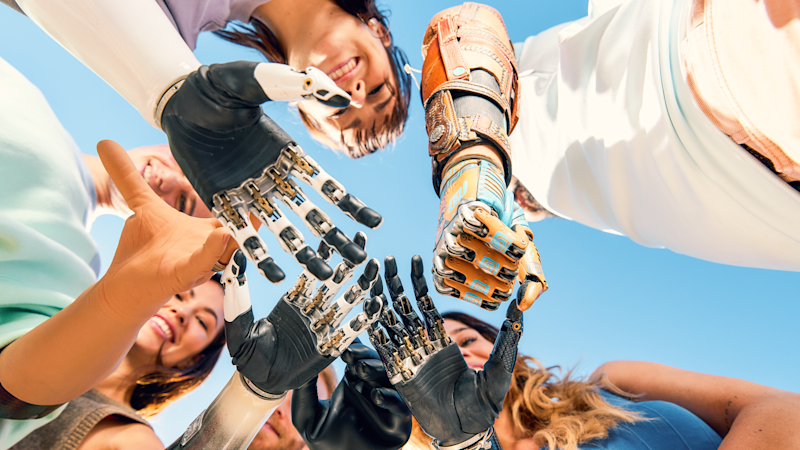Experts highlight developments in the treatment of phantom limb pain
Insights from the Online Upper Limb Prosthetics Symposium

Thursday, 22 May 2025
On Tuesday, 6 May 2025, leading professionals in upper limb prosthetics, discussed about “Advancements in Phantom Limb Sensation and Pain Management”.
Moderated by Dipl.-Ing. Merkur Alimusaj (Head of Technical Orthopaedics, Department for Orthopaedics, Trauma Surgery and Paraplegia – University Clinic Heidelberg, Germany) the online symposium explored the role of phantom limbs in upper limb prosthetics. Amongst others the event highlighted the complex topic of the phantom limb – a phenomen commonly experienced by people with limb loss. It also showcased C.A.L.A. – an innovative visualization and documentation tool for phantom sensation and neuropathic pain – as well as the latest prosthetic technologies including the myosmart control.
Patient-centred collaboration for phantom limb pain and residual limb pain
Globally approximately 57.7 million people live with amputations of which 95% experiencing some form of pain. Phantom limb pain (PLP) and residual limb pain (RLP) often emanate from traumatized or severed peripheral nerves and are more common in upper extremity amputations.
In his presentation, Jamie Vandersea(CPO, Director Upper Extremity Prosthetics, Medical Center Orthotics and Prosthetics, Silver Spring, MD, US) shared latest insights about several causes and treatment opportunities of both PLP and RLP. He highlighted the importance of patient-centered strategies and the integration of cutting-edge prosthetic technology in clinical practice. Common approaches include occupational and physical therapies, prosthetic fittings, pharmacological, surgical and therapeutic methods. Furthermore, Vandersea emphasized the importance of interdisciplinary collaboration in the resolution of PLP and RLP.
C.A.L.A.: an unique project visualizing and documenting phantom limb pain and sensations
Cosima Prahm, PhD MSc BA (Head of the Center for Clinical Research, Clinic for Hand, Replantation, and Microsurgery, BG Klinikum Unfallkrankenhaus Berlin, Germany) gave an overview of the digital tool C.A.L.A. (Computer Assisted Limb Assessment), which was developed by the working group PlayBionic. It supports the documentation and visualization of phantom limb pain and sensations in people with amputations. C.A.L.A. enables patients to use a 3D avatar to localize and characterize various sensory phenomena and pain qualities, such as burning, stabbing, or tingling. They can draw pain and cramp locations directly onto the avatar, quantify the intensity of each sensation, model the shape and position of the phantom limb.
C.A.L.A. is designed to support standardized clinical documentation in both therapeutic and research contexts. All values can be automatically quantified and saved in a patient file. The visual representation of symptom patterns over time can be particularly useful during prosthetic fittings, rehabilitation sessions, or multidisciplinary consultations, Dr Prahm said.
The tool will always be available for free use in scientific collaborations. An online demo version is accessible at: https://playbionic.org/cala-online.
Experience of first test fitting with myosmart
Hans-Magnus Holzfuss (CPO, Managing Partner Gesundheitszentrum Greifswald GmbH, Germany) shared his first test fitting using the new myosmart control system from Ottobock for upper-arm amputees. His patient had to underwent a transhumeral amputation in 2020, following a swimming accident. In 2021, he then received a TMR (Targeted Muscle Reinnervation) surgery and, at the same time, an osseointegration with an OPRA™ implant system.
In January 2025, the patient was able to test the myosmart control for the first time. A separate socket was built to make the fitting as functional as possible. Using four electrodes and a brief introduction to the new myosmart system, the patient was able to generate myoelectric signals and record them using the connectgrip app.
“My user was able to achieve significantly better, safer, and more targeted control with the test prosthesis,” Hans-Magnus said.
Wrap-up
The recent online symposium provided a comprehensive overview of phantom limb, and its hugh impact on the affected people. Insights from C.A.L.A. offered a real part of future when patients could give a feedback and learn more pain and pain sensation.
Merkur Alimusaj showcased myosmart through a test fitting. He stated it is fascinating to see how the new control system supports patients in achieving better functional control of their prosthesis, while enabling faster and more reliable feedback.
Overall, the event underscored the understanding of phantom limb, and its impact on users’ daily lives, as well as highlighting technological improvements in prosthetic control, and the importance. These results offer hope to the affected people struggling with phantom limb and reinforce the need for continued research to refine treatments and fully explore their long-term benefits.
To view the recording of the symposium, please register by clicking on this link: click on this link: Advancements in Phantom Limb Sensation and Pain Management. After sucessful registration, the link to the recording (available until 22 August 2025) will be sent in the conformation email.

